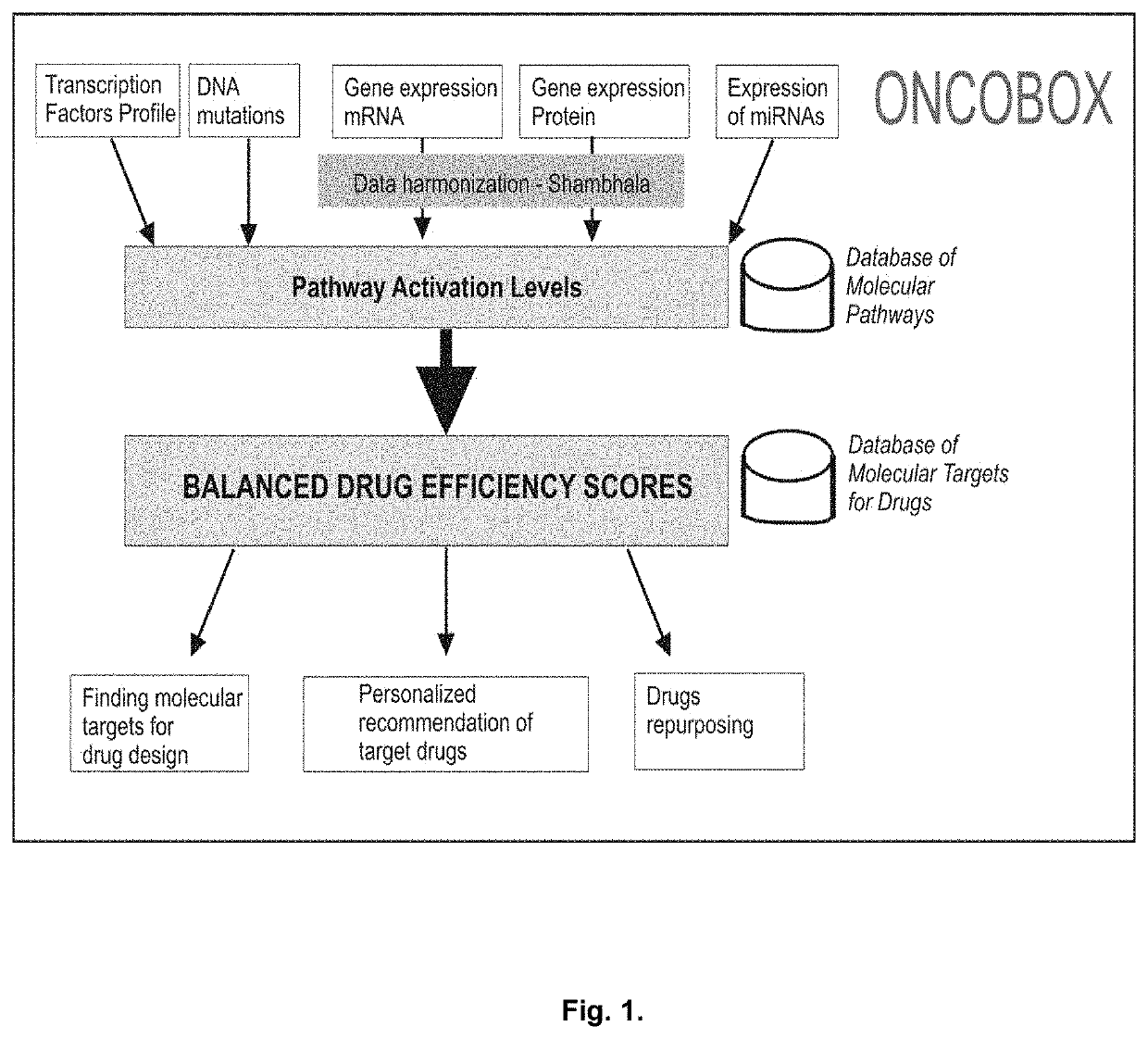Genetic Information Analysis Platform Oncobox
a technology of genetic information and platform, applied in the field of personalized medicine for oncological diseases, can solve the problems of low therapy efficiency, high mortality rate, and large unsolved problem of the right therapy selection for an individual patient, and achieve the effect of predicting clinical efficiencies of targeted drugs
- Summary
- Abstract
- Description
- Claims
- Application Information
AI Technical Summary
Benefits of technology
Problems solved by technology
Method used
Image
Examples
example 1
on of the Molecular Pathway Activation Index Based on Epigenetic Marker Concentration Data
[0162]Genome-wide binding profiles for 225 proteins-human transcription factors (TFs) received by different laboratories in chromatin immunoprecipitation experiments (ChIP-seq) for cell line K562 (erythroleukemia, immortalized cell line) were uploaded from the ENCODE database (https: / / www.encodeproject.orq / chip-seq / transcription factor / ). The profiles represented a control-normalized—TF binding intensities in bedGraph format (https: / / genome.ucsc.edu / goldenpath / help / bedgraph.html). In accordance with the ChIP-seq data processing protocol, the human genome hg19 reference assembly was staged by the Burrows-Wheeler algorithm using BWA program (https: / / www.encodeproject.org / pipelines / ENCPL220NBH / ). fastq-file merge with raw data, alignment to reference genome and filtration were made with BWA, Samtools, Picard, Bedtools and Phantompeakqualtools (https: / / www.encodeproject.org). Profiles of the contro...
example 2
on of Oncological Medicinal Product Activity Rating for Individual Tumour Based on Molecular Pathway Activities According to mRNA Expression Data
[0164]The rating of potentially efficient anti-cancer target drugs for a 72-years old patient with histologically distinctive moderately differentiated intrahepatic cholangiocarcinoma (FIG. 4). The patient was diagnosed in October 2015 with the following symptoms: moderate body weight loss, pain in right hypochondrium, loss of appetite and asthenia, with 70% Karnovsky index. The magnetic resonance imaging (MRI) proved the diagnosis during diagnostics. The tumour was not surgically excised due to advanced stage, several intrahepatic masses and lung metastasis.
[0165]At first, the patient received treatment that was considered the best clinical practice: four courses of chemotherapy (2 courses of gemcitabine combined with capecitabine and next 2 courses of gemcitabine combined with cisplatin) were conducted till May 2016. The treatment was ine...
example 3
Oncology Medicinal Products for Colorectal Cancer Based on Genomic DNA Mutation Data
[0170]The rating of the most relevant target drugs was generated for 105 medicinal products based on genome-wide data of 1,441 cases of colorectal cancer using the Oncobox platform. Data were extracted from database COSMIC v76 (The Catalogue of Somatic Mutations In Cancer) (Forbes et al. 2008) and contained information about 1,165,882 mutations in 19,897 genes.
[0171]The top positions of the rating are shown on Table 3 (nine medicinal products with maximum Balanced Efficiency Score (BES)).
[0172]Table 3. List of medicinal products having the top positions in the rating of potential effective drugs based on MDS.
PUM
| Property | Measurement | Unit |
|---|---|---|
| concentrations | aaaaa | aaaaa |
| activation strength | aaaaa | aaaaa |
| Pathway Activation Strength | aaaaa | aaaaa |
Abstract
Description
Claims
Application Information
 Login to View More
Login to View More - R&D
- Intellectual Property
- Life Sciences
- Materials
- Tech Scout
- Unparalleled Data Quality
- Higher Quality Content
- 60% Fewer Hallucinations
Browse by: Latest US Patents, China's latest patents, Technical Efficacy Thesaurus, Application Domain, Technology Topic, Popular Technical Reports.
© 2025 PatSnap. All rights reserved.Legal|Privacy policy|Modern Slavery Act Transparency Statement|Sitemap|About US| Contact US: help@patsnap.com



